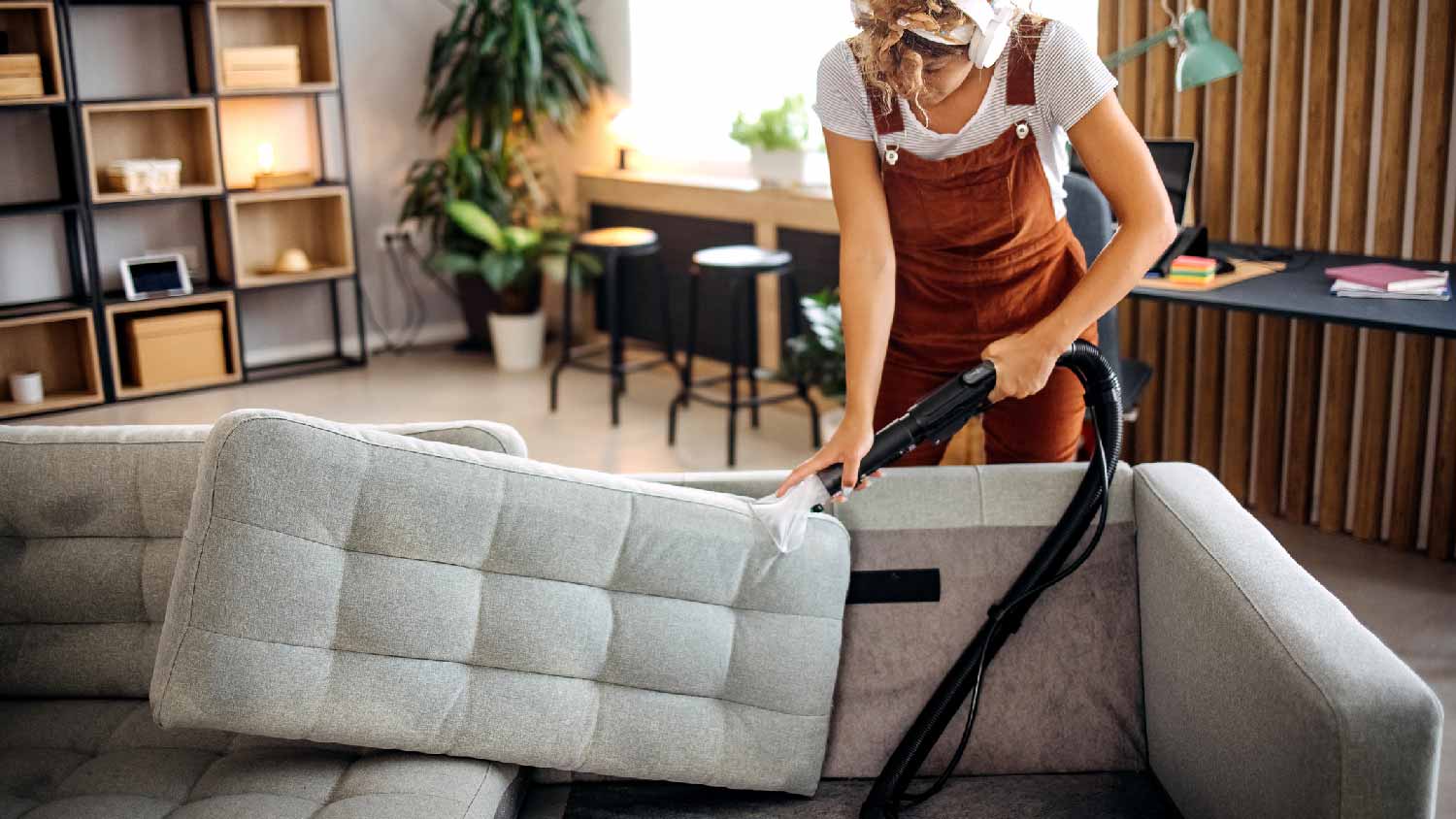How Much Does Ozone Smoke Odor Removal Cost? [2025 Data]
Ozone smoke removal costs an average of $600, and most services total between $400 and $800. Pricing depends mostly on the extent of the damage and the number of rooms affected.


Ozone smoke removal costs an average of $600, but pricing depends on the extent of the smoke damage and the square footage of the area you need treated. You could pay as little as $200 for treatment for minor damage in a single room or as much as $3,000 for multiple services to treat your entire home.
Ozone Smoke Removal Cost Factors
The cost of ozone smoke removal varies based on two key factors: how large of an area you need to treat and how extensive the damage is.
Affected Area

Your professional will set up ozone generators in your home to create ozone that interacts with and breaks down odor-causing compounds. The larger the space you need, the more ozone generators you’ll need for effective treatment. Most professionals charge on a per-room or per-machine basis, which means your cost will increase as the size of the treatment area increases.
| Number of Rooms | Cost Range |
|---|---|
| 1 | $200–$400 |
| 2 | $300–$600 |
| 3 | $400–$800 |
| 5 | $500–$1,000 |
| 10 | $2,000–$3,000 |
Extent of the Damage
The extent and type of smoke damage also play important roles in your costs, as more extensive damage from a large house fire may require additional treatments to remove the odors completely.
For example, you may need two or even three treatments to remove odors from a room where cigarette odors have built up over many years. In that case, your total could climb to $3,000. If you had a small house fire or minor damage from a nearby wildfire, you may need just a single treatment for a small area, which could cost as little as $200.
Temporary Relocation
Ozone quickly breaks down into harmless gases as it interacts with organic compounds in your living space, but while the ozone generator is pumping the gas into your home, you and your family should not be present. Ozone itself can cause respiratory discomfort and worsen issues like asthma and emphysema, so you should consider the cost of alternative housing while the smoke damage restoration process is underway.
Most professionals will recommend treatment for 24 to 36 hours for the best results. If you have a family member, friend, or neighbor you can stay with, relocation may not cost you anything. If you have to rent a hotel or a short-term rental, though, make sure you consider that cost when budgeting for the service.
Ozone Smoke Removal Ongoing Costs

Ozone smoke removal can be an effective way to remove smoke and cigarette odors, but homeowners more often need routine treatments to eliminate lingering smells completely. You can expect to pay an average of $600 for each additional treatment you need, but you may also want to consider the following ongoing services to help get rid of odors for good.
Repeat deep cleanings: It’s often a good idea to couple ozone smoke removal with deep cleanings of furniture and carpeting to get rid of stubborn odors. A single deep cleaning will set you back between $120 and $400, depending on the size of the area. Ask your pro how many of these would be beneficial so you can budget accurately.
Air purification: Installing an air purifier in your home is a good way to reduce the spread of odors to other areas and remove airborne contaminants contributing to the issue. Installing a whole-home air purification system costs between $400 and $5,000, and ongoing running and maintenance costs add up to $50 to $100 per year.
HVAC duct cleaning: Odor-causing contaminants can easily settle in your HVAC ducts and contribute to odor issues throughout the rest of your home. Air duct cleaning costs between $270 and $500, and this service once a year can help avoid odor problems going forward.
DIY Ozone Smoke Removal vs. Hiring a Pro
You can buy ozone generators from your local home improvement store for between $40 and $380, which means it’s technically possible to complete ozone smoke removal as a DIY project. However, it’s best to leave this work to a professional.
According to the Environmental Protection Agency (EPA), ozone is hazardous to your health, and it’s challenging to regulate ozone levels with an ozone generator for a variety of reasons. Leaving the work to a smoke restoration company near you will put the responsibility for safety on an expert, which can help keep you and your family safe. Additionally, a professional will be able to make informed recommendations on additional services that would help eliminate the odor issue you’re dealing with.
Cost of Common Ozone Smoke Removal Add-Ons
Ozone smoke removal can be a powerful tool when it comes to remediating smoke damage and removing stubborn odors from your living space. However, most situations will call for additional services for better results. It’s often not safe to live in a home with extensive smoke damage, so taking a more holistic approach is best.
Below is a list of common add-on options your professional may recommend alongside ozone smoke removal, as well as some large-scale projects you may need to budget for if the smoke odor in your home stems from a more serious issue, like a house fire.
Air duct cleaning cost: $270–$500
Cost to replace flooring: $1,500–$4,900
Cost to replace drywall: $1.50–$3 per sq. ft.
Cost to replace windows: $300–$2,500 per window
Cost to remodel a bathroom: $6,600–$17,600
Cost to remodel a kitchen: $14,600–$41,500
Roof repair cost: $400–$1,900
Structural repair cost: $2,000–$8,500
Fire damage restoration cost: $3,100–$51,200
Tips to Reduce Cost When Scheduling Ozone Smoke Removal
Ozone smoke removal isn’t a terribly expensive solution to removing smoke odors, especially if the alternative is ripping out and replacing building materials. However, with costs sometimes climbing up to $3,000, you may want to use these tips to save money on the service.
Hire a professional. It might be tempting to save money by purchasing an ozone generator and attempting the work yourself. While this will be more affordable, it potentially puts you and your family in danger, and you don’t get the guidance from a pro that can often make the service more effective.
Couple the service with DIY work. Making ozone smoke removal just a single part of your remediation process is best, and you can DIY some other methods to save. Consider deep cleaning your furniture and drapes, removing smoke-damaged materials from your home yourself, painting and sealing the walls and ceilings, and deodorizing carpets.
See if your insurance will cover the cost. If your smoke damage was a result of a house fire or wildfire, your homeowner’s insurance may cover all or some of the cost to remediate smoke damage. Contact your provider first for more information.
How Angi Gets Its Cost Data
Home is the most important place on earth, which is why Angi has helped more than 150 million homeowners transform their houses into homes they adore. To help homeowners with their next project, Angi provides readers with the most accurate cost data and upholds strict editorial standards. We extensively research project costs to develop the pricing data you see, so you can make the best decisions for you and your home. We rely on reputable sources, including the U.S. Bureau of Labor Statistics, academic journals, market studies, and interviews with industry experts—all to ensure our prices reflect real-world projects.
Want to help us improve our cost data? Send us a recent project quote to costquotes@angi.com. Quotes and personal information will not be shared publicly.
Frequently Asked Questions
Ozone does remove smoke smells, and it can be a powerful tool in eliminating stubborn odors from house fires, wildfires, or cigarette smoke in your living space. Ozone or O3 is a highly reactive gas that “donates” its extra oxygen molecule to odor-causing organic compounds. The oxidation process can reduce or even eliminate those compounds’ odors, with oxygen being the primary byproduct.
Ozone can damage building materials and belongings in your home, as the same oxidizing powers that allow it to remove odors can break down other things in your living space. However, it would take long-term exposure for any noticeable damages to occur. Since ozone smoke removal takes 24 to 36 hours, a treatment or two won’t have much of a negative impact on your belongings.
Ozone is an unstable molecule that will naturally break down in a matter of hours, but the exact timeline depends on a few factors. If you have a small concentration of ozone in a room filled with carpets, bedding, and other surfaces that the ozone can react with, it’s likely to dissipate in a matter of minutes. Higher concentrations can take three to four hours. Since ozone can be hazardous to inhale, always wait a minimum of four hours after you shut off an ozone generator to return to the room.















